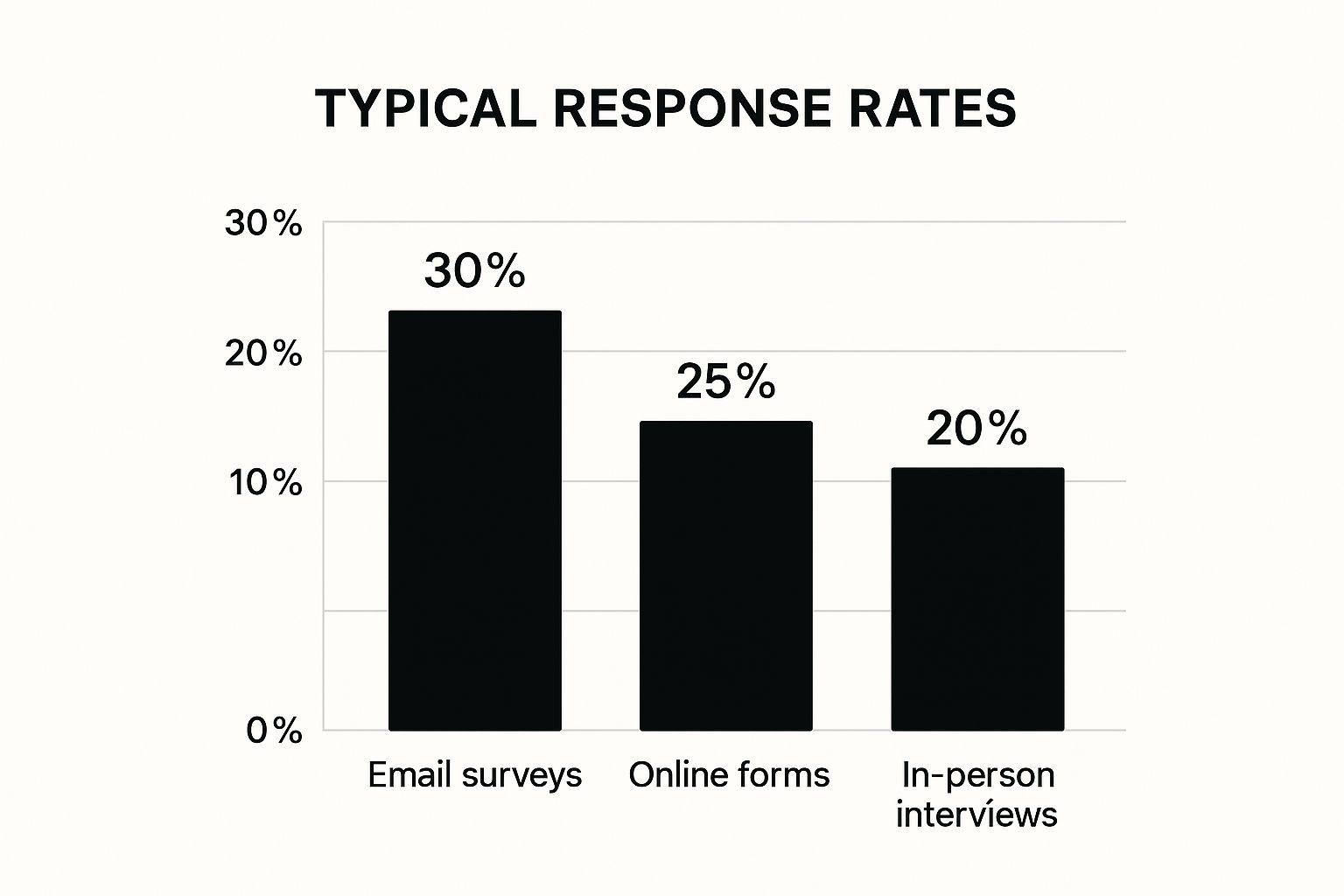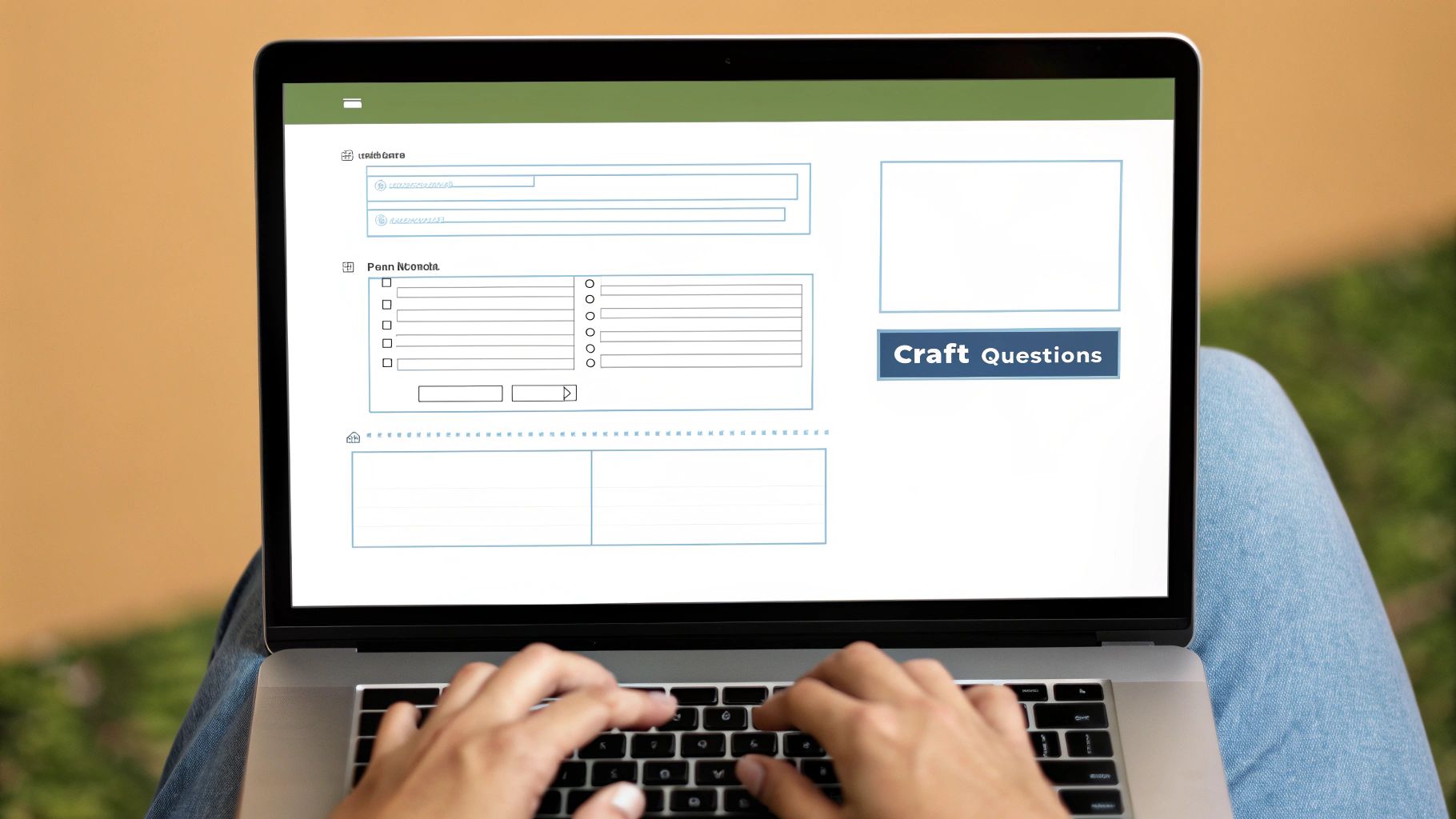customer feedback collection
feedback strategies
customer insights
business improvement
customer experience
How to Collect Customer Feedback That Actually Works
Why Your Current Feedback Collection Is Missing The Mark

Let's be honest: relying only on traditional feedback methods like long annual surveys and generic forms isn't enough anymore. Customer behavior has changed, and sticking to outdated approaches gives you only surface-level responses. These responses don't capture the details of actual customer experiences. This means you're missing key insights that could help improve your product, make customers happier, and boost your profits.
The Problem With Traditional Approaches
One of the biggest issues with traditional feedback is low response rates. How often do you enjoy filling out a long, complicated survey? Most customers don't have the time or the incentive, particularly if they haven't had any major problems. This can skew the data and misrepresent your customer base. Plus, focusing only on requested feedback means you miss out on valuable, unprompted feedback like comments on social media and online reviews.
This is especially true with the declining use of surveys. While surveys are still used in 2025, they are becoming less effective. Only 16% of unhappy customers will complain on social media (down from almost 23% in 2021), and only 22% will post on review sites (down from 26% in 2021). This suggests that open feedback channels like surveys are being used less. Discover more insights about changing consumer behaviors and feedback collection.
Recognizing the Warning Signs
There are a few signs that your current feedback methods need an update. Consistently low survey response rates clearly show your methods aren't working. Another warning sign is an increase in silent customer exits, where customers leave without a word. This suggests they don't feel heard or valued and are taking their business elsewhere without giving you a chance to fix things.
Effective feedback collection needs a multi-pronged approach using various channels and methods. By understanding the limitations of traditional approaches and adopting newer techniques, you can better grasp your customers' needs and preferences. This knowledge helps you make smart decisions to improve your product, enhance customer experiences, and grow your business.
Modern Feedback Collection Methods That Get Real Results
Smart businesses know that gathering customer feedback is no longer a yearly survey affair. It's about engaging with customers where they are, making feedback easy and natural. This requires diverse methods that suit different preferences and capture insights at various touchpoints.
Embracing the Power of Real-Time Feedback
In-app surveys are excellent tools for collecting contextual feedback. Picture a customer completing a key action in your app. This is the ideal moment to present a short, targeted survey about their immediate experience. These micro-feedback opportunities provide valuable insights while the experience is fresh in the user's mind.
Live chat transcripts offer another rich source of real-time feedback. These conversations reveal immediate pain points, like navigation difficulties or confusion about features. This dynamic feedback is often more insightful than static surveys and can lead to quick improvements.
Going Beyond the Survey
Social media listening is vital for understanding customer sentiment. Monitoring mentions, hashtags, and comments provides unfiltered views into customer opinions about your brand and industry. Tools like Sprout Social help you spot trends, identify potential issues, and engage with customers in real time.
Online reviews, found on platforms like Google and Yelp, are packed with information. These reviews often reflect genuine customer experiences. Analyzing this feedback can reveal hidden strengths and weaknesses, providing insights into your public perception.

The infographic above shows typical response rates across three common feedback channels. Email surveys generally achieve a 30% response rate, online forms reach 25%, and in-person interviews garner around 20%. This underscores the importance of using a mix of methods to maximize responses and gather comprehensive insights. While in-person interviews offer deeper qualitative data, they are resource-intensive with lower response rates compared to digital alternatives.
To illustrate the differences between feedback collection methods, let's look at the following comparison:
Customer Feedback Collection Methods Comparison: A comprehensive comparison of traditional vs modern feedback collection methods, showing response rates, implementation difficulty, and effectiveness.
| Method | Response Rate | Implementation Effort | Cost | Best Use Case |
|---|---|---|---|---|
| Email Surveys | 30% | Low | Low | Gathering broad feedback from a large audience |
| Online Forms | 25% | Low | Low | Collecting specific data points on a website |
| In-Person Interviews | 20% | High | High | Deep dive into individual customer experiences |
| In-App Surveys | High (Context-Dependent) | Medium | Low | Gathering immediate feedback within a digital product |
| Social Media Listening | N/A | Medium | Medium | Understanding public sentiment and brand perception |
| Online Reviews | N/A | Low | Low | Monitoring unsolicited customer feedback and identifying areas for improvement |
This table highlights the strengths and weaknesses of each approach. While in-person interviews provide rich qualitative data, they require significant effort. Digital methods like email surveys and online forms are easier to implement and reach a broader audience.
The Importance of Conversational Feedback
User interviews and focus groups offer richer, qualitative data. These methods explore customer motivations and the "why" behind their behavior. While time-consuming, these insights are invaluable for understanding the nuances of customer needs and preferences.
By adopting these modern methods, businesses can collect timely, relevant, and actionable customer feedback. This allows for faster iteration, improved customer satisfaction, and ultimately, business growth. This proactive approach to feedback is essential for staying competitive.
Turning Online Reviews Into Your Feedback Goldmine

Online reviews are more than just marketing tools. They're a wealth of honest customer feedback, offering valuable insights. Many businesses, however, fail to fully utilize this feedback, missing opportunities to enhance their offerings. Understanding how to effectively gather customer feedback from online reviews can provide a significant competitive advantage.
Mining Actionable Insights From Reviews
Consider online review platforms like Yelp and Google Reviews as ongoing, large-scale focus groups. Every review, whether positive or negative, offers a snapshot of a customer's experience. By analyzing these reviews, businesses can identify patterns and trends often missed by traditional feedback methods.
For instance, repeated complaints about slow shipping might indicate a logistical issue needing attention. Conversely, consistent praise for a specific feature confirms its value and suggests potential areas for expansion.
This analysis is even more critical considering the increasing importance of online reviews. 95% of consumers read online reviews before purchasing, with reviews influencing 32% of all purchases – more than discounts or coupons. Find more detailed statistics here. This underscores the need to not just collect, but actively manage and respond to feedback.
Encouraging Authentic Reviews
To get the most out of online reviews, encourage satisfied customers to share their experiences. This doesn't mean pushing for reviews or creating fake ones. Focus on making the review process easy and accessible.
Include clear calls to action on your website and in post-purchase emails, directing customers to relevant review platforms. Using QR codes in physical locations can simplify the review process further.
Responding to Feedback and Building Trust
Responding to reviews, both positive and negative, shows you value customer feedback. This builds trust and strengthens your brand image. A simple thank you acknowledges positive reviews. For negative reviews, a thoughtful response acknowledging the concern and offering a solution can turn a dissatisfied customer into a loyal one.
This responsiveness also signals to potential customers your commitment to improvement. It builds a strong reputation and encourages future business. Directly addressing negative feedback can prevent small issues from escalating and harming your brand, highlighting the value of online reviews as a continuous feedback loop for product and service enhancements.
Leveraging AI To Transform Feedback Into Insights
Artificial intelligence is rapidly changing the way businesses gather and interpret customer feedback. Instead of relying solely on traditional methods like surveys, AI provides the ability to gain real-time insights from a wider range of sources, including social media, online reviews, and even customer support interactions. This allows companies to be more proactive and responsive to customer needs.
AI-Powered Sentiment Analysis
Sentiment analysis, an AI technique, analyzes text to determine the emotional tone behind it. Think about automatically processing thousands of customer emails, chat logs, and survey responses to gauge the overall sentiment. This goes beyond simply identifying keywords; it helps businesses understand how customers feel about their products or services.
This allows for quick identification of areas where customers are satisfied or dissatisfied. For example, if a large number of support tickets express negative sentiment towards a particular feature, it's a clear indication that improvements are needed.
Spotting Trends With AI
Pattern recognition, another powerful AI capability, identifies recurring themes across various feedback channels. This means connecting the dots between social media comments, online reviews, and customer support interactions to gain a holistic understanding of customer experiences.
AI can also be applied to analyze website behavior. By tracking how users interact with a website, businesses can pinpoint pain points in the user journey. This could lead to optimizing site navigation, streamlining the checkout process, or even redesigning specific pages for improved usability. Furthermore, AI can help identify common issues and recurring patterns in customer support tickets.
The adoption of AI for customer feedback analysis is on the rise. Currently, 60% of companies use some form of AI to monitor customer feedback. Those with robust omnichannel listening strategies are 80% more likely to retain customers, as they can quickly identify and address concerns before they escalate. These statistics highlight the significant impact AI is having on how businesses collect and leverage customer feedback to improve customer experiences. Learn more about AI-driven feedback analysis: Find more detailed statistics here.
Combining AI With Human Insight
While AI is undoubtedly a powerful tool, it's important to remember that it's not a replacement for human judgment. The most effective feedback systems combine AI-driven insights with human analysis. AI can be used to efficiently identify trends and patterns, but human team members are essential for adding context, nuance, and understanding to the data.
This combined approach helps avoid misinterpretations and ensures that AI insights are applied strategically. For example, AI might flag a negative social media comment. However, a human can discern whether the comment is a legitimate complaint or simply a sarcastic remark. AI is a valuable tool for collecting customer feedback, but human intelligence remains crucial for accurate interpretation and strategic application of those insights. This synergy between AI and human intellect leads to more informed, data-driven business decisions.
Building Your Complete Feedback Collection System

Building a truly effective feedback system isn't about bombarding your customers with requests. It’s about strategically gathering valuable insights from key interactions. This means choosing the right tools and methods for each step of the customer journey.
Mapping the Customer Journey for Optimal Feedback
Think of the customer journey like a roadmap. From the moment a potential customer discovers your brand to long after they’ve made a purchase, every interaction offers an opportunity for feedback. Mapping this journey helps you identify the best times to ask for feedback, ensuring it feels natural and provides relevant data.
For example, a short satisfaction survey immediately after a purchase can reveal a lot about the checkout experience. Likewise, integrating feedback mechanisms directly within your app or website offers contextual insights into specific features.
Integrating Feedback Across Channels
Today's businesses connect with customers across a variety of channels: websites, apps, social media, customer service interactions, and more. Consistency in your feedback collection process is essential. However, you should also tailor your approach to each platform's unique characteristics.
Actively monitoring social media mentions and comments provides real-time feedback on brand perception. For app users, in-app surveys or feedback buttons offer immediate insights into their experience. This omnichannel approach gives you a complete view of the customer experience, transforming scattered comments into useful business intelligence.
To illustrate this further, let's take a look at the following analysis:
Omnichannel Feedback Touchpoints Analysis
The table below outlines how different customer touchpoints require specific feedback methods and timing for optimal results.
| Touchpoint | Feedback Type | Collection Method | Timing | Expected Response Rate |
|---|---|---|---|---|
| Website | Usability, Feature Requests | Online Forms, In-Page Surveys | Post-Interaction, Exit Intent | Medium |
| In-App | Feature Usage, Bug Reports | In-App Surveys, Feedback Buttons | Post-Task Completion | High |
| Customer Service | Support Quality, Issue Resolution | Post-Interaction Surveys, CSAT Scores | Immediately After Interaction | Medium |
| Social Media | Brand Perception, Sentiment | Social Listening Tools, Direct Engagement | Ongoing | N/A |
As the table demonstrates, timing is critical. Asking for feedback immediately after an interaction often leads to higher response rates and more accurate insights. Each touchpoint offers unique opportunities to gather specific types of feedback.
Prioritizing and Organizing Feedback
Collecting feedback from multiple sources can quickly become overwhelming. A system for organizing and prioritizing this information is essential for turning insights into action.
Start by categorizing feedback based on topic and sentiment. This allows you to identify recurring themes and pinpoint areas that need immediate attention. Then, prioritize feedback based on its potential impact on customer satisfaction and business goals. This ensures your efforts focus on the most impactful improvements.
By creating a system that streamlines the collection, organization, and prioritization of feedback, you can transform scattered comments into a powerful source of business intelligence. This will not only drive meaningful improvements but also strengthen customer relationships.
Turning Customer Insights Into Real Business Changes
Collecting customer feedback is valuable only if it leads to tangible improvements. This section focuses on creating systems that ensure customer insights translate into real business changes, not just endless meetings. This means building a structured approach to analyzing feedback and implementing changes based on what you learn.
Prioritizing Actionable Insights
Think of customer feedback like a triage system in a hospital. Not all feedback requires immediate action. Learn to categorize feedback by impact and urgency. For example, a bug preventing users from completing a purchase is high urgency and high impact.
A suggestion for a new feature, while potentially valuable, is lower urgency. This focus ensures you prioritize the improvements that deliver the biggest gains in customer satisfaction.
From Insights to Action Items
Feedback without follow-up is like a compass without a map. You know the direction, but not how to get there. Successful businesses create accountability systems.
This might involve assigning specific teams to address certain types of feedback, setting deadlines for implementation, and tracking progress. Communicating changes back to customers is crucial.
Whether through a blog post, a social media update, or an email newsletter, showing customers that their feedback resulted in action builds loyalty. This demonstrates that their voices are heard and valued.
Measuring the Impact of Changes
How do you know if your feedback-driven changes are working? Establish clear success metrics. If you addressed a bug reported through customer support tickets, track the number of subsequent tickets related to that same issue.
A decrease in those tickets indicates the fix was effective. Additionally, monitor overall customer satisfaction metrics like NPS scores to gauge the long-term impact of your changes.
Building Continuous Improvement Loops
Customer feedback isn't a one-time event; it's an ongoing conversation. Build continuous improvement loops by regularly collecting feedback, analyzing it, implementing changes, and then measuring the results.
This iterative process ensures you stay aligned with evolving customer needs and keep your product or service improving. By actively engaging customers in this evolution, you foster a sense of partnership and build long-term loyalty.
This ongoing dialogue helps you stay ahead of the curve and proactively adapt to changing market demands, creating a stronger, more resilient business.
Key Takeaways
This section offers a practical guide to building effective systems for collecting customer feedback. It covers implementation checklists, metrics for measuring success, realistic timelines for businesses of all sizes, and advice on sidestepping common problems. Each takeaway provides actionable steps you can use immediately, along with clear indicators for tracking your progress.
Understand Why Feedback Matters
Customer feedback is essential. It helps you understand customer needs, improve their experience, and build trust and loyalty. It also fuels innovation. Customer feedback is the foundation of data-driven decisions that lead to real business growth. Without a robust feedback system, you're operating without crucial information.
Diversify Your Feedback Channels
Don't limit yourself to traditional surveys. Explore various methods, such as in-app surveys, social media listening, online reviews, user interviews, and focus groups. Each method provides unique insights into different aspects of the customer experience. Just like assembling a puzzle, each piece contributes to the complete picture.
Make Feedback Easy and Engaging
Minimize hurdles in the feedback process. Short, targeted surveys, embedded feedback buttons within your product, and easy access to review platforms encourage higher response rates. The easier it is for customers to provide feedback, the more likely they are to share their thoughts.
Analyze and Act on Feedback
Collecting feedback is just the first step. You need systems to categorize, prioritize, and analyze the data. Look for recurring themes and focus on improvements that will have the biggest impact on customer satisfaction. For instance, multiple reports of the same bug clearly indicate the need for immediate attention.
Close the Feedback Loop
When you make changes based on customer feedback, inform your customers. This shows them that their input is valued, builds trust, and encourages future feedback. It creates a two-way conversation.
Use AI to Enhance Your Analysis
AI-powered tools can analyze large volumes of feedback data, identifying sentiment and uncovering patterns that manual analysis might miss. However, it's crucial to combine these AI insights with human judgment to ensure accuracy and context. AI is a powerful tool, but human understanding is still essential.
Key Metrics for Success
Track key metrics such as survey response rates, customer satisfaction scores (like NPS), and the number of implemented changes based on feedback. These metrics provide quantifiable proof of your feedback system's effectiveness. This data-driven approach helps you continually improve your strategies.
Building a Sustainable Feedback Culture
Building a successful feedback system is an ongoing journey. Regularly review your methods, adapt to changing customer behaviors, and cultivate a culture of continuous improvement. Treat feedback as a valuable asset that drives your business growth.
Learn more about how AnotherWrapper can help you build successful AI projects.
Fekri




